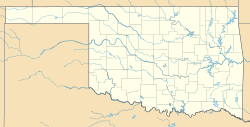Alsuma, Oklahoma facts for kids
Quick facts for kids
Alsuma, Oklahoma
Welcome (1905), Trovillion
or Troxillion (1926) |
|
|---|---|
| Country | United States |
| State | Oklahoma |
| County | Tulsa County |
| Elevation | 660 ft (201 m) |
| Time zone | CST |
| Area code(s) | 918 |
Alsuma was a small community located between the cities of Tulsa and Broken Arrow in Oklahoma. It started as a rural area in Tulsa County.
The community's post office opened in 1905 and was first called Welcome. It was renamed Alsuma in 1906. One story says the town was named after a local merchant, John Alsuma. Another legend suggests it was named for three women: Alice, Susan, and Mabel. Their names were combined to create "Alsuma."
At its largest, Alsuma covered about 165 acres (67 ha) and was home to 75 families. The post office closed in 1926. Today, Alsuma is known as a ghost town. However, people in southeast Tulsa still use the name to refer to that specific area.
Contents
How Alsuma Grew and Changed
The Railroad's Role
The Missouri, Kansas and Texas Railroad (also known as MKT or Katy) was very important to Alsuma. It ran right through the community. The railroad built a station in Alsuma in 1909.
This first station closed in 1940. But the railroad opened another station in 1943, which stayed open until 1971. In 1926, the railroad tried to rename the station Trovillion or Troxillion. However, the new sign kept getting stolen, so they eventually put the Alsuma sign back up.
Life in Alsuma
Some old newspapers described Alsuma as one of Oklahoma's "black towns." This meant it was mainly settled by African Americans. However, people who used to live there remember that white families also lived in Alsuma.
The railroad tracks actually divided the community. There were separate areas for white and black families. Alsuma had its own school specifically for black children. White children, though, went to Union High School, which was a much better facility. After segregation became illegal, all the children transferred to the Union School, and the Alsuma school closed for good.
Early Airports Near Alsuma
The area around Alsuma was a good spot for early airfields. In 1931, two airport companies merged. This new facility was first called Garland-Clevenger Airport. By 1934, it was known as Tulsa Commercial Airport.
The airport moved a short distance southwest by 1937, still close to Alsuma. It was built on 160 acres (65 ha) of land. It had a grass runway and two hangars. In 1951, an oilman named Walter Brown bought the airport. He renamed it Brown's Air Service and started making improvements. He added more hangars, paved runways, and a building with an office and a restaurant. Brown Airport operated for over ten years. By 1964, it closed down, and the land was used to build houses.
Alsuma Becomes Part of Tulsa
In 1966, the city of Tulsa officially took over Alsuma. This is called annexation. For several years after, Tulsa did not provide city services like water and sewer to the area. They also didn't allow new buildings to be constructed. Residents couldn't even build new septic tanks.
In 1969, Tulsa planned to turn Alsuma into an industrial park. This was part of a program called Urban Renewal. The entire area was changed to be used for factories and businesses. Finally, in 1971, Tulsa finished extending the sewer and water systems to Alsuma.
What's Left of Alsuma Today
Today, there are very few physical signs of the old Alsuma within Tulsa's city limits. You can find the area on 51st Street, between Mingo Road and the Mingo Valley Expressway.
Alsuma used to have its own park. Both black and white children played there, even during the time of segregation when this was not allowed in Tulsa's city parks. The Tulsa Park and Recreation Department still lists Alsuma Park at 9801 E. 51st Street as a recreation area. However, it is mostly used to manage storm water now. There are soccer fields in the pond area, but all the playground equipment is gone. Some homes still remain, but officially, Alsuma is considered a ghost town.


